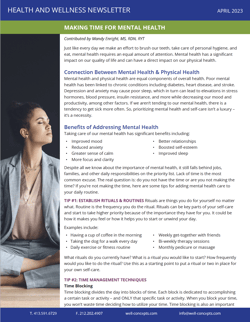MAKING TIME FOR MENTAL HEALTH
Contributed by Mandy Enright, MS, RDN, RYT
Just like every day we make an effort to brush our teeth, take care of personal hygiene, and eat, mental health requires an equal amount of attention. Mental health has a significant impact on our quality of life and can have a direct impact on our physical health.
Connection Between Mental Health & Physical Health
Mental health and physical health are equal components of overall health. Poor mental health has been linked to chronic conditions including diabetes, heart disease, and stroke. Depression and anxiety may cause poor sleep, which in turn can lead to elevations in stress hormones, blood pressure, insulin resistance, and more while decreasing our mood and productivity, among other factors. If we aren’t tending to our mental health, there is a tendency to get sick more often. So, prioritizing mental health and self-care isn’t a luxury – it’s a necessity.
Benefits of Addressing Mental Health
Taking care of our mental health has significant benefits including
- Improved mood
- Reduced anxiety
- Greater sense of calm
- More focus and clarity
- Better relationships
- Boosted self-esteem
- Improved sleep
Despite all we know about the importance of mental health, it still falls behind jobs, families, and other daily responsibilities on the priority list. Lack of time is the most common excuse. The real question is: do you not have the time or are you not making the time? If you’re not making the time, here are some tips for adding mental health care to your daily routine.
TIP #1: ESTABLISH RITUALS & ROUTINE
Rituals are things you do for yourself no matter what. Routine is the frequency you do the ritual. Rituals can be key parts of your self-care and start to take higher priority because of the importance they have for you. It could be how it makes you feel or how it helps you to start or unwind your day. Examples include:
- Having a cup of coffee in the morning
- Taking the dog for a walk every day
- Daily exercise or fitness routine
- Weekly get-together with friends
- Bi-weekly therapy sessions
- Monthly pedicure or massage
TIP # 2: TIME MANAGEMENT TECHNIQUES
Time Blocking
Time blocking divides the day into blocks of time. Each block is dedicated to accomplishing a certain task or activity – and ONLY that specific task or activity. When you block your time, you won’t waste time deciding how to utilize your time. Time blocking is also an important tool for your mental health routine. Can you block out a few time slots in your day to take breaks and focus on your mental health?
Time Batching (or Chunking)
Like time blocking, time batching is when you batch similar tasks together. This helps eliminate switching between different tasks and saves valuable time and mental energy. This can include reading and responding to emails or having all meetings at a certain time.
Pomodoro Technique
Identify a task to complete, then set a timer for 25 minutes. After 25 minutes of working distraction-free, take a 5-minute break. Repeat 3 more times, take a 30-minute break, and then start again. Use your breaks to step away, refresh, and come back to the task re-focused. There are several productivity apps that feature this technique.
TIP # 3: TAKE ADVANTAGE OF TECH
1. Smartphone Settings
Turn on features like “do not disturb,” set time limits on apps, and even schedule a downtime for your phone when it can’t be used except for calls. See your phone’s “Settings” feature.
2. Wearable Devices
Many wearable devices like smart watches have reminders for small mental health boosting activities like standing, breathing, and mindfulness.
3. Apps for Mental Health
There are a multitude of apps to help with your mental health. Many offer a variety of options based on how much time you need in your day to reset:
- Meditation & Mindfulness Apps: Calm, Headspace, Buddhify, Breethe, Aura
- Mood Boosters: MoodMission, Happify, Think Up, MindShift CBT
- Calm Anxiety: MindShift, Sanvello, Breathe2Relax
3. Online Therapy Options
Online therapy offers the convenience of working with a therapist anywhere and any time of day. Some accept insurance, or you can utilize your HSA or FSA. Check your EAP benefits to learn more about options offered through your employer. Popular online therapy options include Talkspace, BetterHelp, Cerebral, and AmWell.
When it comes to mental health, it’s important to treat it like any other part of your daily well-being routine. Consider pairing your mental health routine with something that’s already a regular part of your day, such as taking a few calming deep breaths before eating lunch or practicing mindfulness before opening your laptop in the morning. The more mental health becomes part of your daily routine, the less it feels like something “else” you have to worry about fitting into your day.
How do you make time for mental health and your own self-care?
![]()
Mandy Enright MS, RDN, RYT, is a Registered Dietitian, Yoga Instructor, and Corporate Wellness Expert, as well as main content contributor for Wellness Concepts. Mandy is a featured presenter, both virtually and onsite near her home in Neptune, NJ.


